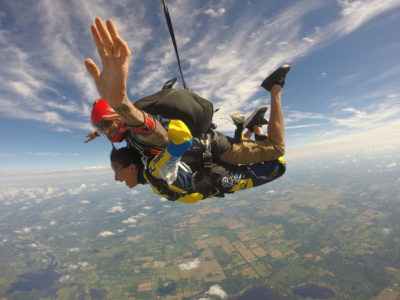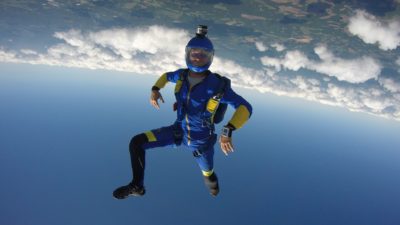- Michigan's Premier Skydiving Center
- Call Now: (517) 423-7720
Skydiving Positions and The Arch
Wednesday, December 16, 2020
- Skydive Tecumseh
- 12/16/20
- 0
- General
There are essential skydiving positions for a successful and safe experience. This took a while to come to be known across the industry. Here is a quick history and breakdown of the basic arch position to more advanced body positions while freefalling through the sky.
Way back when a bunch of former WW2 paratroopers began eyeing up their old equipment and wondering if they could use it just for fun, not a lot was understood about freefall. People used to believe it was necessary to remain tucked into a ball until the time came to deploy your parachute, as the force of the wind might be enough to tear your limbs clean off. Over time we figured out that: not only was this not a problem, but while falling with your belly pointing at the ground you could use your arms and legs to aid with stability and even control your movement in the sky. This led to the birth of the well-known skydiving arch body position.
The Correct Skydiving Position: The Arch
 The most important skydiving position – the one you most likely picture when thinking of skydiving in your brain – is known as belly flying. This is when you fall in an arched position with your belly button pointing at the ground and your chin up looking forward. This is the easiest way to find stability and keeps your parachute in the right place (pointing upwards) for the whole jump. For these reasons, the belly skydiving position is used for both tandem skydiving and when you learn to skydive solo.
The most important skydiving position – the one you most likely picture when thinking of skydiving in your brain – is known as belly flying. This is when you fall in an arched position with your belly button pointing at the ground and your chin up looking forward. This is the easiest way to find stability and keeps your parachute in the right place (pointing upwards) for the whole jump. For these reasons, the belly skydiving position is used for both tandem skydiving and when you learn to skydive solo.
Getting The Arch Right:
You can practice the belly skydiving position by lying on the ground on your front. Lift your chin up and look forward, then arch your body by picking up your hands, feet, shoulders, and knees until your hips and belly are the only parts still touching the ground. Don’t worry that even a few seconds of this exercise feels like hard work – when you do it for real you are supported by the force of the wind and will not even notice it taking any effort to hold for the whole jump.
Other Body Positions (Good):
There are a few other positions you will be asked to perform when doing a tandem skydive. When you exit the plane you will be asked to cross your arms over your chest so together, you and the instructor can perform a nice clean exit. When on the final approach under your parachute, you will be instructed to lift your legs up for landing by bending 90 degrees at the waist. These are easy positions to remember and you will be shown exactly what to do by your instructor during the briefing before you go.
Other Body Positions (Not So Good):
The belly skydiving position with a nice arch is very stable. If you don’t do this during freefall – by balling up, keeping your arms crossed, or tucking your knees, there may be some instability. However, your instructor is skilled and trained to control the descent regardless. However – it does mean that they will have to work harder throughout if you are acting like a sack of potatoes instead of helping to fly. Also, your lack of stability will mean that you feel less graceful and lose a little bit of the awesomeness of what freefall is supposed to be like when you relax and nail it.
Advanced Skydiving Positions:
 Over time people have learned that there are many skydive positions for your body and that with enough practice people can freefall in pretty much any orientation they choose. Belly flying starts simple but gets super technical when teams compete to create the most formations in a single jump. ‘Tracking’ is when you make your body shape all pointy to move fast across the sky – at first just to get space from others for safe deployment, but later to zoom around in groups with your friends. Freefly is when you use your limbs to hold yourself in funky shapes – typically with your ‘head up’ or your ‘head down’. As you progress these all start to merge and blend into basically anything you can dream up.
Over time people have learned that there are many skydive positions for your body and that with enough practice people can freefall in pretty much any orientation they choose. Belly flying starts simple but gets super technical when teams compete to create the most formations in a single jump. ‘Tracking’ is when you make your body shape all pointy to move fast across the sky – at first just to get space from others for safe deployment, but later to zoom around in groups with your friends. Freefly is when you use your limbs to hold yourself in funky shapes – typically with your ‘head up’ or your ‘head down’. As you progress these all start to merge and blend into basically anything you can dream up.
Conclusion:
Skydiving is not just a bucket-list essential, it is a richly rewarding sport that allows you to get started pretty quickly but takes a lifetime master. Whether you join us for a tandem jump or set foot on the path to getting a skydiving license of your own – jumping from an airplane is the best thing ever and can change your life. Join us!
Copyright © 2025, Skydive Tecumseh, All Rights Reserved.
DropZone Web Design & Marketing by Beyond Marketing, LLC
